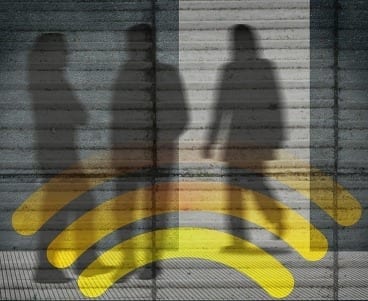
‘Wi-Vi’ is based on a concept similar to radar and sonar imaging.
The comic-book hero Superman uses his X-ray vision to spot bad guys lurking behind walls and other objects. Now we could all have X-ray vision, thanks to researchers at MIT’s Computer Science and Artificial Intelligence Laboratory.
Researchers have long attempted to build a device capable of seeing people through walls. However, previous efforts to develop such a system have involved the use of expensive and bulky radar technology that uses a part of the electromagnetic spectrum only available to the military.
Now a system being developed by Dina Katabi, a professor in MIT’s Department of Electrical Engineering and Computer Science, and her graduate student Fadel Adib, could give all of us the ability to spot people in different rooms using low-cost Wi-Fi technology. “We wanted to create a device that is low-power, portable and simple enough for anyone to use, to give people the ability to see through walls and closed doors,” Katabi says.
The system, called “Wi-Vi,” is based on a concept similar to radar and sonar imaging. But in contrast to radar and sonar, it transmits a low-power Wi-Fi signal and uses its reflections to track moving humans. It can do so even if the humans are in closed rooms or hiding behind a wall.
As a Wi-Fi signal is transmitted at a wall, a portion of the signal penetrates through it, reflecting off any humans on the other side. However, only a tiny fraction of the signal makes it through to the other room, with the rest being reflected by the wall, or by other objects. “So we had to come up with a technology that could cancel out all these other reflections, and keep only those from the moving human body,” Katabi says.
Motion detector
To do this, the system uses two transmit antennas and a single receiver. The two antennas transmit almost identical signals, except that the signal from the second antenna is the inverse of the first. As a result, the two signals interfere with each other in such a way as to cancel each other out. Since any static objects that the signals hit — including the wall — create identical reflections, they too are cancelled out by this nulling effect.
In this way, only those reflections that change between the two signals, such as those from a moving object, arrive back at the receiver, Adib says. “So, if the person moves behind the wall, all reflections from static objects are cancelled out, and the only thing registered by the device is the moving human.”
Once the system has cancelled out all of the reflections from static objects, it can then concentrate on tracking the person as he or she moves around the room. Most previous attempts to track moving targets through walls have done so using an array of spaced antennas, which each capture the signal reflected off a person moving through the environment. But this would be too expensive and bulky for use in a handheld device.
So instead Wi-Vi uses just one receiver. As the person moves through the room, his or her distance from the receiver changes, meaning the time it takes for the reflected signal to make its way back to the receiver changes too. The system then uses this information to calculate where the person is at any one time.
Possible uses in disaster recovery, personal safety, gaming
Wi-Vi, being presented at the Sigcomm conference in Hong Kong in August, could be used to help search-and-rescue teams to find survivors trapped in rubble after an earthquake, say, or to allow police officers to identify the number and movement of criminals within a building to avoid walking into an ambush.
It could also be used as a personal safety device, Katabi says: “If you are walking at night and you have the feeling that someone is following you, then you could use it to check if there is someone behind the fence or behind a corner.”
The Latest Bing News on:
Wi-Fi signal to track moving humans
- 12 Vital Security System Maintenance Tasks You’re Skipping—And How That Makes Your Home Vulnerableon April 26, 2024 at 8:46 am
Learn More › Installing a security system is a great way to boost home security and grant you peace of mind that you, your family, and your belongings are safe. Security system maintenance is crucial ...
- Here comes the Sun - space-based solar power in the spotlighton April 26, 2024 at 2:24 am
Could 24/7 solar power from orbit be the answer to the world's future energy challenges? KATE ARKLESS GRAY reports from the International Conference on Energy from Space 2024, held at RAeS HQ, on ...
- Extreme Connect 2024: Agencies Can Use Wi-Fi 6E Connectivity Outdoorson April 24, 2024 at 8:56 am
Peña, IT director for the city of Pharr, Texas, said that the enhanced capabilities of Extreme Networks infrastructure ensures that the city can continue to innovate. “We have been doing public Wi-Fi ...
- Welcome to Pricing Hellon April 16, 2024 at 4:00 am
Previously self-contained products (toothbrushes, movies, Microsoft Word) have turned into subscriptions, while previously bundled items (Wi-Fi at hotels ... Companies adopted sophisticated software ...
- Tech expert reveals the worst place to position a Wi-Fi router – does yours need relocating for better signal?on April 13, 2024 at 6:00 am
Sharing the best place for a WiFi router as a result of exposing how certain spots hinder your router’s performance ...
- San Francisco’s Train System Still Uses Floppy Disks—and Will for Yearson April 11, 2024 at 10:00 am
Much more critical than the dated use of floppy disks is the system's loop cable, which transmits data between the central servers and the trains, and, according to Roccaforte, “has less bandwidth ...
The Latest Google Headlines on:
Wi-Fi signal to track moving humans
[google_news title=”” keyword=”Wi-Fi signal to track moving humans” num_posts=”10″ blurb_length=”0″ show_thumb=”left”]
The Latest Bing News on:
Wi-Vi
- All console commands and cheats for Fallout: New Vegason April 26, 2024 at 12:00 pm
Opening up the command console to type in your cheats is just a single keystroke away. While in the game (not paused), hit the ~ key located below your escape key. This will remove your HUD and bring ...
- Richmond exhibit explores how slavery caused the Civil Waron April 26, 2024 at 8:00 am
The American Civil War Museum’s new exhibit, "The Impending Crisis," explores differing viewpoints in pre-Civil War America, providing a view of what led to what is arguably the most pivotal ...
- CWI slammed for state of WI cricket at Caricom symposiumon April 25, 2024 at 8:01 pm
Regional heads and former cricketing greats yesterday lambasted Cricket West Indies (CWI) for the state of the game and its organisation in the Caribbean.
- 7 Best Home Warranty Companies of May 2024on April 25, 2024 at 12:26 pm
Limited coverage for the first 90 days Not available in California, Florida, Illinois, Texas, Washington or Wisconsin Few years in the industry Elite Home Warranty is one of the few companies that ...
- Petlibro’s new smart refrigerated wet food feeder is what your cat deserveson April 25, 2024 at 9:58 am
Petlibro, pet tech startup that designs automatic food dispensers for cats, launched its first refrigerated smart feeder.
- T-Mobile, EQT Form JV To Acquire Fiber-to-the-home Platform Lumoson April 25, 2024 at 9:23 am
T-Mobile (TMUS) and investment firm EQT announced Thursday they have entered into a joint venture (JV) with EQT's Infrastructure VI ...
- T-Mobile, EQT Form JV to Buy Fiber Optic Company Lumoson April 25, 2024 at 6:27 am
T-Mobile and EQT have formed a joint venture with EQT's Infrastructure VI fund to buy fiber-to-the-home platform Lumos ... more than 7,500 route miles with fiber optic internet and home wi-fi service ...
- DATA: How green building can prove resilient against natural disasterson April 24, 2024 at 8:36 am
The most common natural hazards can be broken into five categories: wind, flood, fire, earth, and temperature.
- Too Much Power for Spy Agencieson April 23, 2024 at 1:02 pm
This past week, quickly and with little public awareness, Congress markedly expanded government’s power to snoop on its citizens. At a time of worry about privacy, government overreach, and “the Deep ...
- WI Academy stuns Pride to hand Harpy Eagles titleon April 20, 2024 at 4:29 pm
Openers Rashawn Worrell and Kadeem Alleyne struck contrasting but critical half-centuries as West Indies Academy produced a clinical run chase to stun Barbados Pride by three wickets ...
The Latest Google Headlines on:
Wi-Vi
[google_news title=”” keyword=”Wi-Vi” num_posts=”10″ blurb_length=”0″ show_thumb=”left”]









